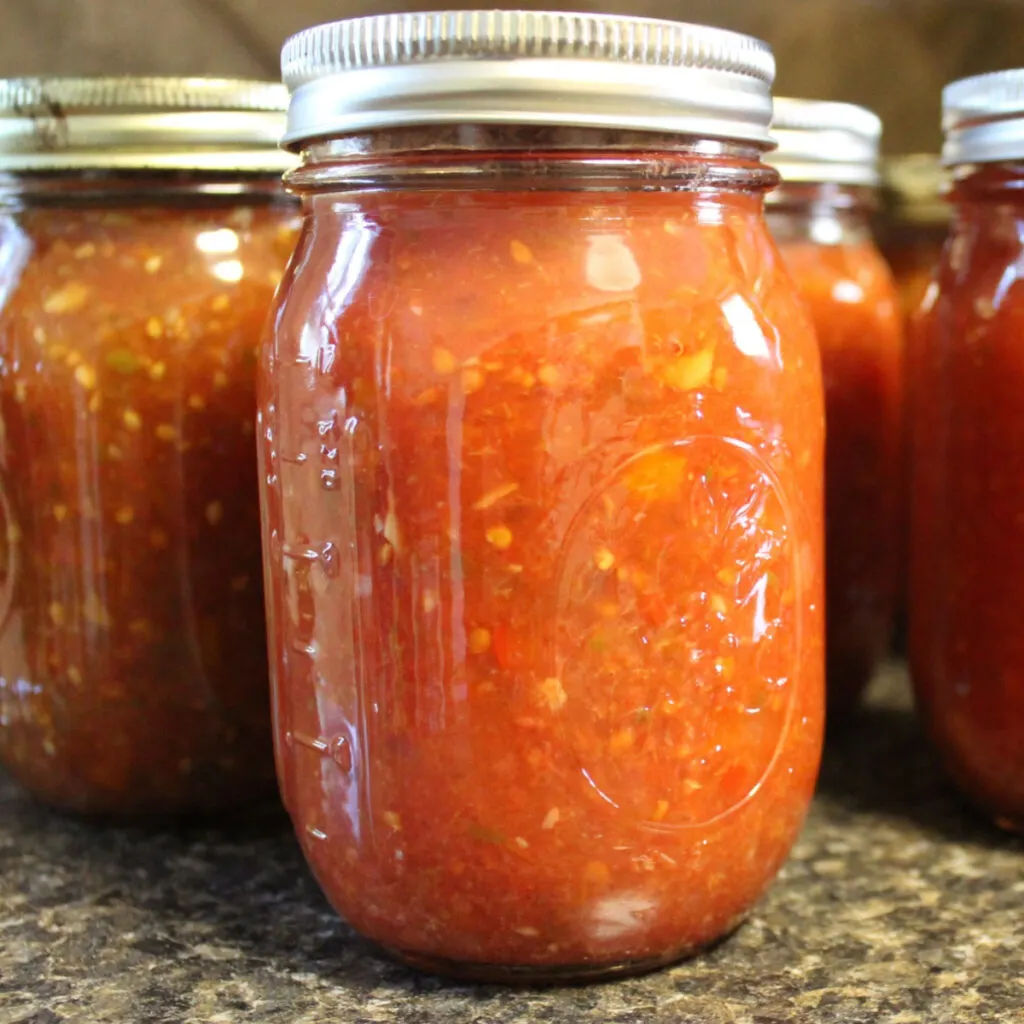Now that the tomatoes and peppers are starting to ripen in the garden, it is time to share our favorite homemade salsa recipe for canning or freezing. Although we make several different varieties of salsa, this one is by far the most popular.
It is a standard, slightly chunky salsa recipe that is a favorite among our family and friends. We use it to serve with tortilla chips as an appetizer. And we will also open a jar and use it as a condiment for tacos, burritos, nachos and more!
The best part of this recipe is that it is so easy to make. In fact, even the novice cook can master this recipe by following the simple instructions outlined below.
And that includes the canning process. With the use of basic canning equipment, you can have homemade salsa to enjoy all year long. And don’t worry if you don’t have time to process the jars of salsa, you can freeze it instead.
However, I prefer to can the salsa and save space in my freezer. Although there are a few important steps to follow to make sure that the jars of salsa turn out perfect every time.
Tips For Canning Homemade Salsa
1. Use Fresh Ingredients
One of the most important tips when making canned salsa is to use fresh ingredients for best results. For instance, it is important to use tomatoes that are ripe, but not overly ripe and beginning to turn soft.
However, if you follow the guidelines in this article: When To Pick Tomatoes, you will have to wait a few days until the tomatoes are fully ripe before using them in this recipe.
And the same holds true for the peppers and onions. If you want that classic crunch of peppers and onions when you take a bite of canned salsa, be sure to use only vegetables that are nice and firm.
2. What Type of Tomatoes Makes The Best Salsa?
Second, you must decide what type of tomatoes that you are going to use to make your salsa. Whenever possible use some variety of paste tomatoes.
They are traditionally oblong and are smaller in diameter than standard slicing tomatoes. However, they have thicker walls and less juice in them, which makes them hold up well during the canning process.
These varieties are commonly known as Roma, San Marzano or Amish Paste tomatoes. However, you may also find them generically labeled as paste tomatoes at the store or Farmer’s Market.
If you don’t have enough paste tomatoes to make your homemade salsa, you can certainly use slicing or cherry tomatoes as well. Although, be sure to not use more than 25% of tomato varieties that are low-acid.
The lack of acidity in these types of tomatoes will negatively impact the pH levels for safe canning practices. However, you can use the low acid tomatoes to make salsa but you will need to store it in the refrigerator or freezer instead.
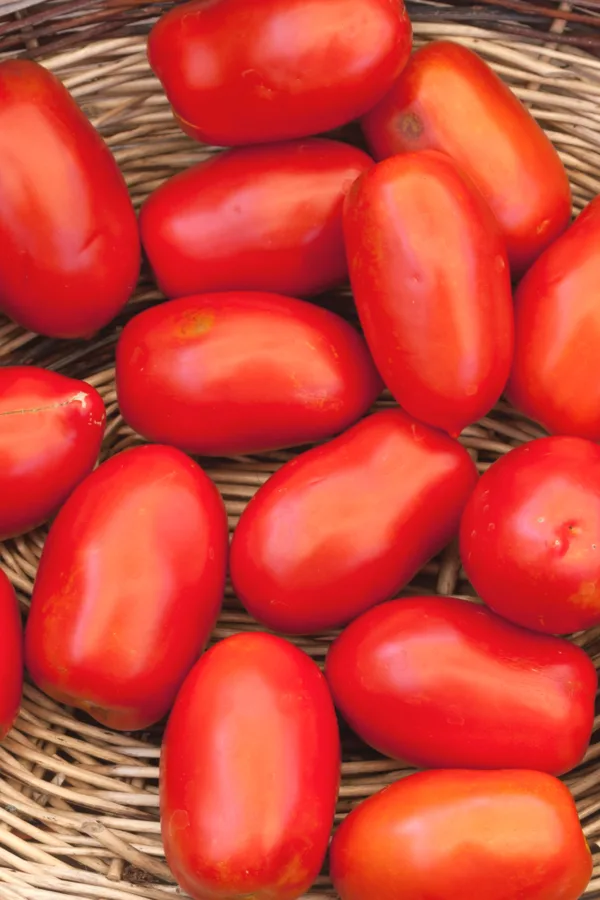
The Best Homemade Salsa Recipe
*Complete recipe instructions including specific measurements, cook temperatures and times are located in a printable recipe card at the bottom of this article. However, be sure to keep reading for helpful tips and tricks when making this recipe.
INGREDIENTS
- 10 cups peeled cored & diced paste tomatoes (about 30-35)
- 6 cups diced peppers mixture of mild and hot (about 5 large green peppers and 6-8 hot peppers)
- 4 cups chopped onions (about 6 medium onions)
- 3 cloves garlic (peeled)
- 2 Tablespoons finely chopped cilantro
- 1 Tablespoon salt
- ½ teaspoon black pepper
- 1 cup distilled white vinegar (5%)
INSTRUCTIONS
The first step in making homemade salsa is to peel the skin off of the tomatoes.
If left on, the skins will shred off during the cooking and preserving process. As a result, you will have strips of skin floating in your salsa making the texture unpleasing to many.
However, peeling tomatoes is a relatively easy process.
Start by filling a large stockpot with water and bring it to a boil over medium-high heat. Then submerge the whole tomatoes in the water for approximately 1 minute.
Using a slotted spoon or ladle, immediately remove the tomatoes and place them in an ice water bath. This will stop the cooking process.
Then once the tomatoes are cool enough to handle, make a tiny cut in the skin and peel the tomatoes. The skin should come off easily.
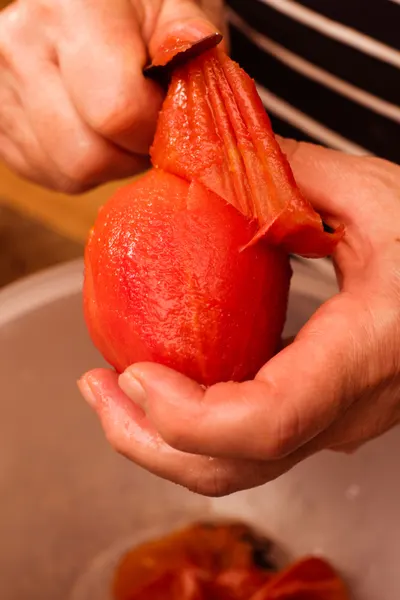
Remove The Pulp And Seeds
The next step in making homemade salsa is to remove the pulp and seeds of your tomatoes and discard.
Simply cut your tomatoes in half, or in quarters for large tomatoes, and squeeze the tomato until the pulp and seeds squirt out.
However, there is no need to make sure every seed has been removed. A few seeds in canned salsa is totally acceptable.
Dicing The Vegetables
Next comes the task of cutting your vegetables into small pieces.
For the tomatoes, be sure to dice them a little larger than what you want the size to be in your canned salsa. The tomatoes hold a lot of water and will break down during the cooking and canning process.
However, the same is not true for the peppers and onions. You will want to cut them to the desired size.
Yes, they will soften and break down a bit, but definitely not as much as the tomatoes.
We use our Hamilton Beach Food Processor to make cutting the peppers, onions, and garlic a breeze. This saves us a considerable amount of time when we are making homemade salsa.
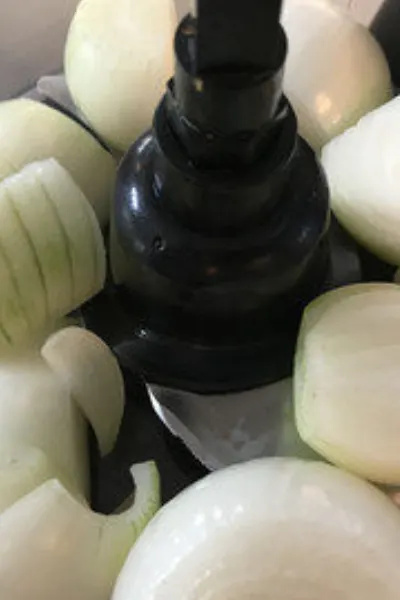
The Canning Process
Now that you have your vegetables prepared, it is time to make the best canned salsa that you have ever had.
Start by adding all of the ingredients to a large stockpot and place over medium-high heat. Bring the mixture to a boil.
While you are waiting for the salsa to heat up, prepare the canning jars and equipment.
Fill clean, pint size mason jars with water and place them upright in a hot water bath canner. Then pour enough water in the pot that it comes right to the top rim of the mason jars.
Add undamaged bands in with the jars and then place the pot on the stove over medium-high heat. Bring the water to a low simmer, but do not let it come to a full boil. Keep the jars in the water until you are ready to fill them with the salsa.
When it comes to the canning lids you will most likely not have to heat them. Several years ago a new technology emerged with canning lids called Sure-Tight lids.
It is recommended that these lids are no longer heated before topping the filled canning jars. However, be sure to read the labels carefully to see the instructions for your specific brand.
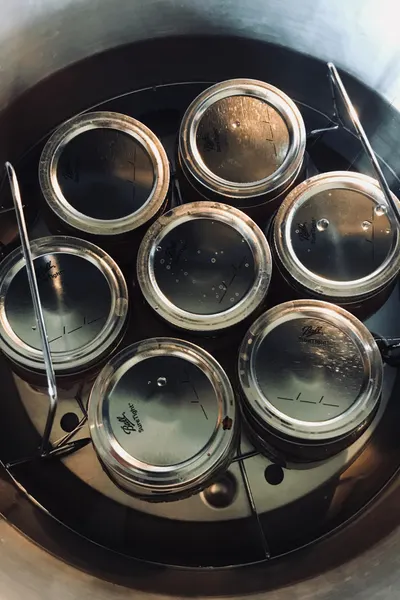
Hot Water Bath Canning
Once your homemade salsa has boiled for 15 minutes, reduce the heat to a simmer. Once the salsa is ready and the mason jars are hot it is time to start canning!
Using a jar lifter, remove one mason jar and dump the hot water back into the pot. Then place the jar on a thick kitchen towel next to your pot of salsa.
Place a wide mouth funnel on top of the jar and fill it with the simmering salsa. However, be sure to leave a 1/2 inch head space at the top of the jar to allow for expansion during the canning process.
Next, wipe the rim of the jar with a clean washcloth. Then place the lid on the mason jar and finger tighten the band.
Then using the jar lifter, place the filled jar back into the pot and repeat the process until all the jars have been filled.
At this point, the water should be 1-2 inches above the top of the jars. If not, be sure to add additional water so that the canned salsa can be safely processed.
Turn the pot to HIGH heat, cover and bring the water to a boil. Once it begins to boil start the timer and let it continue at a rolling boil for 15 minutes, adjusting for altitude as required.
Once the time is up, turn off the burner and let the jars sit in the hot water for 5 minutes. Then use the jar lifter to carefully lift the jars out of the hot water and place on a thick towel.
Let the jars cool for 24 hours.

Checking For Sealed Jars
Before storing your canned salsa, you must check to make sure that each jar has properly sealed. Push down on the center of the lid and if there is any movement, the jars are not safe for storing at room temperature.
Place the non-sealed jars in the refrigerator and eat within 1-2 weeks. The remaining sealed jars can be stored in a cool, dark place for up to one year.
Serving Canned Salsa
When you are ready to use a jar of homemade canned salsa, we recommend adding in a few fresh ingredients to make it even better!
Dice up a little fresh onion and bell pepper and add it to your salsa along with some cilantro and garlic salt.
The hint of fresh ingredients makes the flavor of your canned salsa the best salsa that you have ever had!
Enjoy!
Mary and Jim

Jim and Mary Competti have been writing gardening, DIY and recipe articles and books for over 15 years from their 46 acre Ohio farm. The two are frequent speakers on all things gardening and love to travel in their spare time.
As always, feel free to email us at thefarm@owgarden.com with comments, questions, or to simply say hello! You can sign up for our free email list in the subscribe now box in the middle of this article. Follow us on Facebook here : OWG Facebook. This article may contain affiliate links.
Homemade Canned Salsa
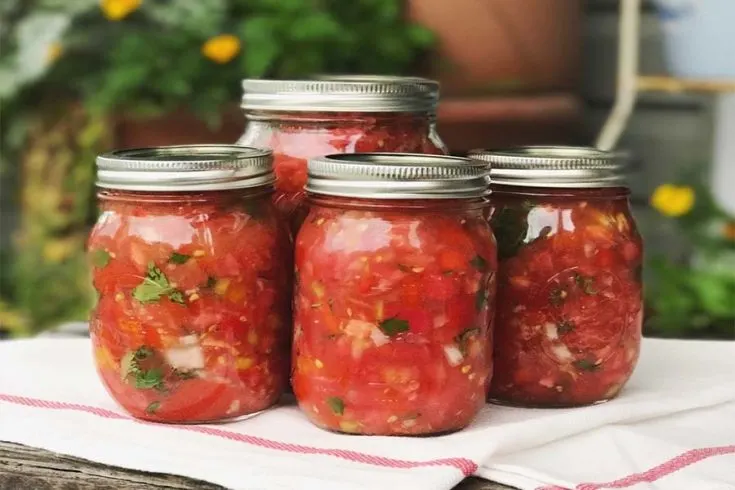
How to make the best canned salsa using fresh vegetables. An easy recipe that includes water bath canning instructions.
Ingredients
- 10 cups peeled cored (diced paste tomatoes (about 30-35)
- 6 cups diced peppers mixture of mild and hot (about 5 large green peppers and 6-8 hot peppers)
- 4 cups chopped onions (about 6 medium onions)
- 3 cloves garlic (peeled)
- 2 Tablespoons finely chopped cilantro
- 1 Tablespoon salt
- ½ teaspoon black pepper
- 1 cup distilled white vinegar (5%)
Instructions
- In a large pot fill ¾ full of water and bring to a boil. Place whole tomatoes in the pot for 1 minute and then immediately remove and place them into an ice water bath for 1 additional minute.
- Remove from the water, and once safe enough to handle peel the skins off. Discard the skins.
- Over a large bowl, squeeze the majority of the pulp and juice out of each tomato and discard, Dice tomatoes in sections slightly larger than the tomatoes you would typically find in your salsa. Add to a large stock pot.
- Remove seeds and ribs of the peppers – roughly chop them and place them in a food processor. Pulse until finely chopped, or finely hand chop the peppers. Add the peppers to the tomatoes in the stock pot.
- Roughly chop onions and place them in your food processor. Add the peeled garlic to the onions and pulse until they are finely chopped.
- Add chopped onions, garlic, cilantro, salt, pepper, and vinegar to the pot.
- Heat on Medium-High heat until it begins to boil. Reduce heat and simmer for 15 minutes, stirring frequently.
- Add to sterilized and heated pint jars leaving 1/2” headspace. Wipe the rim, and add a lid and hand finger tighten the ring. Process in a hot water bath for 15 minutes, adjusting time for altitude variances.
- Once the time is up, turn off the heat and let the jars sit in the water for 5 minutes. Then carefully remove jars by using a jar lifter and place on a thick towel and let cool for 24 hours.
- Before storing, check to make sure all jars are sealed by pushing on the lid -if it doesn’t move it is sealed properly. If it didn’t seal, immediately add to your refrigerator and use within 2 weeks.
Notes
- If you prefer hot salsa do not remove the ribs or seeds of the hot peppers.
- Store sealed jars on cool dark shelf for up to 12 months.
Recipe courtesy of Old World Garden Farms
Nutrition Information:
Yield:
9Serving Size:
1 pintAmount Per Serving: Calories: 75Total Fat: 0gSaturated Fat: 0gTrans Fat: 0gUnsaturated Fat: 0gCholesterol: 0mgSodium: 711mgCarbohydrates: 16gFiber: 2gSugar: 7gProtein: 2g
Nutritional Information is to be used as a general guideline only . Nutritional calculations will vary from the types and brands of the products used.

